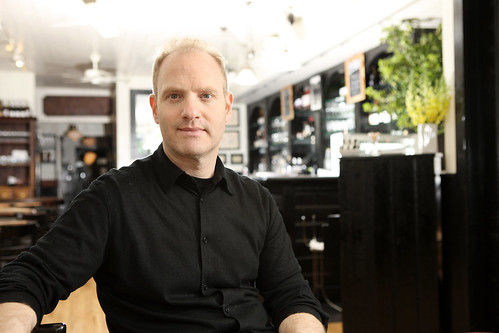There can never be too much ice at a seafood spot with a popular raw bar. Danny Abrams, owner of The Mermaid Inn, estimates that every day his restaurant at 96 Second Avenue goes through significantly more than the 1,500 pounds his two ice machine hold collectively. “I can’t keep up,” he told The Local. “It’s never enough, especially on the busy nights and during happy hour.” Come March 23 the Mermaid will need quite a bit of ice: as previously mentioned, it’s celebrating its ten-year anniversary and the launch of weekend lunch. To find out how the restaurant has made it a decade, we chilled with its owner.
How many oysters do you sell a year roughly?
We sold probably $350,000 in just the East Village location in 2012. (There are Mermaid Inns also in the West Village and Upper West Side.)
Are the times of $1 oysters during happy hour numbered with the rise in fish costs?
Not for us. For me it is worth it even though we don’t make money on those oysters, but we don’t lose any either. People enjoy oysters for $1 and they usually get drinks and other items too. If they were coming in and just getting six oysters for $6, I’d reconsider. But I think the happy hour is often what brings people in to check us out. I look at it as a marketing cost
Is selling seafood cost affective?
It’s certainly not as profitable as other types of food. Our food costs are more in the 34 percent cost range vs. the 28 percent cost range. Usually you want your food purchases to be about 28 percent of your sales. Seafood is more difficult.
What inspired you to open a seafood restaurant in the East Village?
Back in 2003, my partner and I just wanted to open a simple New England fish shack. My partner at the time wanted to recreate the kinds of places he went to as a child growing up in Rhode Island. We looked around for a place and found a spot we liked in the East Village. When we first opened we only had twenty-nine seats in the front room. Several months later we expanded to a backroom. Now we have sixty, with ten at the bar.
Do you have a partner now?
I don’t have a partner now. It’s just me running things.
How is business?
There was a long stretch of us being really busy when we first opened. In 2008, 2009, 2010 it seemed like lots of restaurants were opening and closing in the neighborhood and the streets weren’t as crowded. Then, a few years ago, things began to pick up again. I’d say overall it’s been a bit up and down.
Why do you think some restaurants close and then others like yours seem to survive and sustain?
There are a lot of restaurants that are well run and serve good food and then they don’t make it. Then there are restaurants that do the opposite and somehow do make it. We have always been consistent with our food and service, which I think has been important to our survival, but overall it’s all a mystery to me. You can’t control a lot of variable in the restaurant industry. You have a fighting chance of survival if the environment, attention to detail, level of service, plating and taste are solid. You can’t control the weather and whether people come in or not. All I can do is control what it’s like once they enter.
What have you been controlling lately from the inside? Any renovations?
We care a lot about value and price. Also, if something doesn’t work we fix it and repair it fast. When things look shabby, we repaint or replace. We recently changed the color scheme in the back room. We removed a black carpet and put in a new wood floor. We are redoing the tabletops to give the place a more natural feel. Basically, we’re going for a more modern sensibility. I don’t mean architectural, but lighter and crisper.
How much have you spent on these changes?
We’ve spent about $30,000 this winter between the redoing our back room to purchasing all new cafe furniture.
I imagine there must be more stress running a fresh fish restaurant than other kinds of restaurants?
The health department is much more rigorous with fish restaurants and especially ones that serve raw seafood. We work hard to keep our “A” in the window. The hurricane was a big stress for us. We lost all our product and business for six days. I think between the loss of product and the days we were closed, we lost $70,000. That was tough. We got some money from insurance. The neighborhood hasn’t been as busy this winter as past winters either. But overall we’re doing fine.
As your ten-year anniversary approaches, looking back did you get a good deal on your rent?
We got a pretty fair deal then. We renegotiated in ’10 or ’11 and it went up about 50 percent but I still think we got a fair deal. Times have changed. I just look at it as: “Can I still make money with this change in rent?”
What is the future for Mermaid Inn?
I want to open more Mermaids. I have three now. We are looking at different neighborhoods. By 2013 you will see another Mermaid open. We’ll stay in Manhattan for another one or two restaurants, but we’ll eventually look in Brooklyn.




